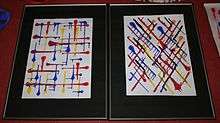Acrylic paint
Acrylic paint is a fast-drying paint made of pigment suspended in acrylic polymer emulsion. Acrylic paints are water-soluble, but become water-resistant when dry. Depending on how much the paint is diluted with water, or modified with acrylic gels, mediums, or pastes, the finished acrylic painting can resemble a watercolor, a gouache or an oil painting, or have its own unique characteristics not attainable with other media.[2]


History
Otto Röhm invented acrylic resin, which was quickly transformed into acrylic paint. As early as 1934, the first usable acrylic resin dispersion was developed by German chemical company BASF, which was patented by Rohm and Haas. The synthetic paint was first used in the 1940s, combining some of the properties of oil and watercolor.[3] Between 1946 and 1949, Leonard Bocour and Sam Golden invented a solution acrylic paint under the brand Magna paint. These were mineral spirit-based paints.[4] Acrylics were made commercially available in the 1950s.
Following that development, Golden came up with a waterborne acrylic paint called "Aquatec".[5] In 1953, Jose L. Gutierrez produced Politec Acrylic Artists' Colors in Mexico, and Henry Levinson of Cincinnati-based Permanent Pigments Co. produced Liquitex colors. These two product lines were the very first acrylic emulsion artists' paints.[6]
Water-based acrylic paints were subsequently sold as latex house paints, as latex is the technical term for a suspension of polymer microparticles in water. Interior latex house paints tend to be a combination of binder (sometimes acrylic, vinyl, pva, and others), filler, pigment, and water. Exterior latex house paints may also be a co-polymer blend, but the best exterior water-based paints are 100% acrylic, due to elasticity and other factors. Vinyl, however, costs half of what 100% acrylic resins cost, and polyvinyl acetate (PVA) is even cheaper, so paint companies make many different combinations of them to match the market.[7]
Soon after the water-based acrylic binders were introduced as house paints, artists and companies alike began to explore the potential of the new binders. Water-soluble artists' acrylic paints were sold commercially by Liquitex beginning in the 1950s, with modern high-viscosity paints becoming available in the early '60s. In 1963, Rowney (part of Daler-Rowney since 1983) was the first manufacturer to introduce artist's acrylic paints in Europe, under the brand name "Cryla".[2]
Painting with acrylics
Before the 19th century, artists mixed their own paints,[8] which allowed them to achieve the desired color and thickness, and to control the use of fillers, if any. While suitable media and raw pigments are available for the individual production of acrylic paint, hand mixing may not be practical because of the fast drying time and other technical issues, such as the necessity to combine several polymers, as well as surfactants, plasticizers, dispersants, defoamers and stabilisers in the correct amounts and order.
Acrylic painters can modify the appearance, hardness, flexibility, texture, and other characteristics of the paint surface by using acrylic mediums[9] or simply by adding water. Watercolor and oil painters also use various mediums, but the range of acrylic mediums is much greater. Acrylics have the ability to bond to many different surfaces, and mediums can be used to modify their binding characteristics. Acrylics can be used on paper, canvas and a range of other materials, however their use on engineered woods such as medium-density fiberboard can be problematic because of the porous nature of those surfaces.[10] In these cases it is recommended that the surface first be sealed with an appropriate sealer. Acrylics can be applied in thin layers or washes to create effects that resemble watercolors and other water-based mediums. They can also be used to build thick layers of paint—gel and molding paste are sometimes used to create paintings with relief features. Acrylic paints are also used in hobbies such as trains, cars, houses, DIY projects, and human models. People who make such models use acrylic paint to build facial features on dolls,[11] or raised details on other types of models. Wet acrylic paint is easily removed from paintbrushes and skin with water, whereas oil paints require the use of a hydrocarbon.
Acrylic paints are the most common paints used in grattage, a surrealist technique that became popular with the advent of acrylic paint. Acrylics are used for this purpose because they easily scrape or peel from a surface.[12]
Painting techniques
Acrylic artists' paints may be thinned with water or acrylic medium and used as washes in the manner of watercolor paints, but unlike watercolor the washes are not rehydratable once dry. For this reason, acrylics do not lend themselves to the color lifting techniques of gum arabic-based watercolor paints. Instead, the paint is applied in layers, sometimes diluting with water or acrylic medium to allow layers underneath to partially show through. Using an acrylic medium gives the paint more of a rich and glossy appearance, whereas using water makes the paint look more like watercolor and have a matte finish.[13]

Acrylic paints with gloss or matte finishes are common, although a satin (semi-matte) sheen is most common. Some brands exhibit a range of finishes (e.g. heavy-body paints from Golden, Liquitex, Winsor & Newton and Daler-Rowney); Politec acrylics are fully matte.[14] As with oils, pigment amounts and particle size or shape can affect the paint sheen. Matting agents can also be added during manufacture to dull the finish. If desired, the artist can mix different media with their paints and use topcoats or varnishes to alter or unify sheen.
When dry, acrylic paint is generally non-removable from a solid surface if it adheres to the surface. Water or mild solvents do not re-solubilize it, although isopropyl alcohol can lift some fresh paint films off. Toluene and acetone can remove paint films, but they do not lift paint stains very well and are not selective. The use of a solvent to remove paint may result in removal of all of the paint layers (acrylic gesso, et cetera). Oils and warm, soapy water can remove acrylic paint from skin. Acrylic paint can be removed from non-porus plastic surfaces, such as miniatures or models using certain cleaning products such as Dettol (containing chloroxylenol 4.8% v/w)[15]
An acrylic sizing should be used to prime canvas in preparation for painting with acrylic paints, to prevent Support Induced Discoloration (SID). Acrylic paint contains surfactants that can pull up discoloration from a raw canvas, especially in transparent glazed or translucent gelled areas. Gesso alone will not stop SID; a sizing must be applied before using a gesso.[16][17]
The viscosity of acrylic can be successfully reduced by using suitable extenders that maintain the integrity of the paint film. There are retarders to slow drying and extend workability time, and flow releases to increase color-blending ability.
Properties
Grades
Commercial acrylic paints come in two grades:
- Artist acrylics (professional acrylics) are created and designed to resist chemical reactions from exposure to water, ultraviolet light, and oxygen.[18] Professional-grade acrylics have the most pigment, which allows for more medium manipulation and limits the color shift when mixed with other colors or after drying.[19][20]
- Student acrylics have working characteristics similar to artist acrylics, but with lower pigment concentrations, less-expensive formulas, and fewer available colors. More expensive pigments are generally replicated by hues. Colors are designed to be mixed even though color strength is lower. Hues may not have exactly the same mixing characteristics as full-strength colors.[19][20]
Varieties
- Heavy body acrylics are typically found in the Artist and Student Grade paints. "Heavy Body" refers to the viscosity or thickness of the paint. They are the best choice for impasto or heavier paint applications and will hold a brush or knife stroke and even a medium stiff peak. Gel Mediums ("pigment-less paints") are also available in various viscosities and used to thicken or thin paints, as well as extend paints and add transparency.[21]
- Examples of Heavy Body Acrylics are Matisse Structure Acrylic Colors, Lukas Pastos Acrylics, Liquitex Heavy Body Acrylics and Golden Heavy Body Acrylics.
- Medium viscosity acrylics – Fluid acrylics, Soft body acrylics, or High Flow acrylics – have a lower viscosity but generally the same pigmentation as the Heavy Body acrylics. Available in either Artist quality or Craft quality, the cost and quality vary accordingly. These paints are good for watercolor techniques, airbrush application, or when smooth coverage is desired. Fluid acrylics can be mixed with any medium to thicken them for impasto work, or to thin them for glazing applications.[22]
- Examples of fluid acrylics include Lukascryl Liquid, Lukascryl Studio, Liquitex Soft Body and Golden Fluid acrylics.
- Open acrylics were created to address the one major difference between oil and acrylic paints: the shortened time it takes acrylic paints to dry. Designed by Golden Artist Colors, Inc. with a hydrophilic acrylic resin, these paints can take anywhere from a few hours to a few days, or even weeks, to dry completely, depending on paint thickness, support characteristics, temperature, and humidity.[23]
- Iridescent, pearl and interference acrylic colors combine conventional pigments with powdered mica (aluminium silicate) or powdered bronze to achieve complex visual effects. Colors have shimmering or reflective characteristics, depending on the coarseness or fineness of the powder. Iridescent colors are used in fine arts and crafts.
- Acrylic gouache is like traditional gouache because it dries to a matte, opaque finish. However, unlike traditional gouache, the acrylic binder makes it water-resistant once it dries.[24] Like craft paint, it will adhere to a variety of surfaces, not only canvas and paper. This paint is typically used by water-colorists, cartoonists, or illustrators, and for decorative or folk art applications.
- Examples of acrylic gouache are Lascaux Gouache and Turner Acryl Gouache.
- Craft acrylics can be used on surfaces besides canvas, such as wood, metal, fabrics, and ceramics. They are used in decorative painting techniques and faux finishes to decorate objects of ordinary life. Although colors can be mixed, pigments are often not specified. Each color line is formulated instead to achieve a wide range of premixed colors. Craft paints usually employ vinyl or PVA resins to increase adhesion and lower cost.[25]
- Interactive acrylics are all-purpose acrylic artists' colors which have the characteristic fast-drying nature of artists' acrylics, but are formulated to allow artists to delay drying when they need more working time, or re-wet their work when they want to do more wet blending.
- Exterior acrylics are paints that can withstand outdoor conditions. Like craft acrylics, they adhere to many surfaces. They are more resistant to both water and ultraviolet light. This makes them the acrylic of choice for architectural murals, outdoor signs, and many faux-finishing techniques.
Differences between acrylic and oil paint

The vehicle and binder of oil paints is linseed oil (or another drying oil), whereas acrylic paint has water as the vehicle for an emulsion (suspension) of acrylic polymer, which serves as the binder. Thus, oil paint is said to be "oil-based", whereas acrylic paint is "water-based" (or sometimes "water-borne").


The main practical difference between most acrylics and oil paints is the inherent drying time. Oils allow for more time to blend colors and apply even glazes over underpaintings. This slow-drying aspect of oil can be seen as an advantage for certain techniques, but it impedes an artist trying to work quickly. The fast evaporation of water from regular acrylic paint films can be slowed with the use of acrylic retarders. Retarders are generally glycol or glycerin-based additives. The addition of a retarder slows the evaporation rate of the water.
Oil paints may require the use of solvents such as mineral spirits or turpentine to thin the paint and clean up. These solvents generally have some level of toxicity and are often found objectionable. Relatively recently, water-miscible oil paints have been developed for artists' use. Oil paint films can become increasingly yellow and brittle with time; they lose much of their flexibility in a few decades. Additionally, the rules of "fat over lean" must be employed to ensure the paint films are durable.
Oil paint has a higher pigment load than acrylic paint. As linseed oil contains a smaller molecule than acrylic paint, oil paint is able to absorb substantially more pigment. Oil provides a refractive index that is less clear than acrylic dispersions, which imparts a unique "look and feel" to the resultant paint film. Not all the pigments of oil paints are available in acrylics and vice versa, as each medium has different chemical sensitivities. Some historical pigments are alkali sensitive, and therefore cannot be made in an acrylic emulsion; others are just too difficult to formulate.[26] Approximate "hue" color formulations, that do not contain the historical pigments, are typically offered as substitutes.[27][28]
Due to acrylic paint's more flexible nature and more consistent drying time between layers, an artist does not have to follow the same rules of oil painting, where more medium must be applied to each layer to avoid cracking. It usually takes 15–20 minutes for one to two layers of acrylic paint to dry. Although canvas needs to be properly primed before painting with oil to prevent it from eventually rotting the canvas, acrylic can be safely applied straight to the canvas. The rapid drying of acrylic paint tends to discourage blending of color and use of wet-in-wet technique as in oil painting. Even though acrylic retarders can slow drying time to several hours, it remains a relatively fast-drying medium and adding too much acrylic retarder can prevent the paint from ever drying properly.
Meanwhile, acrylic paint is very elastic, which prevents cracking from occurring. Acrylic paint's binder is acrylic polymer emulsion – as this binder dries, the paint remains flexible.[29]
Another difference between oil and acrylic paints is the versatility offered by acrylic paints. Acrylics are very useful in mixed media, allowing the use of pastel (oil and chalk), charcoal and pen (among others) on top of the dried acrylic painted surface. Mixing other bodies into the acrylic is possible—sand, rice, and even pasta may be incorporated in the artwork. Mixing artist or student grade acrylic paint with household acrylic emulsions is possible, allowing the use of premixed tints straight from the tube or tin, and thereby presenting the painter with a vast color range at their disposal. This versatility is also illustrated by the variety of additional artistic uses for acrylics. Specialized acrylics have been manufactured and used for linoblock printing (acrylic block printing ink has been produced by Derivan since the early 1980s), face painting, airbrushing, watercolor-like techniques, and fabric screen printing.
Another difference between oil and acrylic paint is the cleanup. Acrylic paint can be cleaned out of a brush with any soap, while oil paint needs a specific type to be sure to get all the oil out of the brushes. Also, it is easier to let a palette with oil paint dry and then scrape the paint off, whereas one can easily clean wet acrylic paint with water.[30]
See also

Notes and references
- Here, the word describes a technique that allows more time before the paint dries.
- "Art Materials". Daler Rowney. 2012-02-15. Retrieved 2013-02-05.
- Phaidon Press (2001). The 20th-Century art book (Reprinted. ed.). London: Phaidon Press. ISBN 0714835420.
- Terry Fenton online essay about Kenneth Noland, and acrylic paint, accessed April 30, 2007
- "A History of GOLDEN Artist Colors, Inc". Golden Artist Colors, Inc.
- Painting With Acrylics (Watson-Guptill publications)
- "Water-based Alchemy by Dean Sickler". Archived from the original on August 29, 2012. Retrieved August 11, 2012.
- Hermens, Erma. "The colour of imagination". BBC. BBC. Retrieved 31 August 2019.
- "How to Modify Acrylic Paint with Mediums". My Blue Print. My Blue Print. 7 April 2019.
- Sealing, Staining, and Filling Archived 2010-08-03 at the Wayback Machine Wood Finishing and Refinishing accessed December 08, 2010,
- Medaris Culea, Patti (2005). Creative Cloth Doll Faces: Using Paints, Pastels, Fibers, Beading, Collage. Quarry Books. p. 64. ISBN 159253144X.
- Grattage Art Techniques accessed December 08, 2010
- Staff, Artists Network (2016-10-11). "2 Ways to Thin Acrylic Paint | Painting with Acrylics for Beginners". Artists Network. Retrieved 2020-02-03.
- "Val Green's Art Space – Acrylic Painting". www.valgreen.com. Retrieved 2016-03-31.
- Removing Acrylic Paint From Skin Instructions accessed December 08, 2010
- Preparing A Painting Support accessed December 17, 2017
- OPEN Acrylics, Shellac, and SID accessed December 17, 2017
- Brady, Patti (December 29, 2008). rethinking acrylic. Cincinnati, Ohio: North Light Books. p. 16. ISBN 978-1600610134.
- Kemp, Will (22 September 2011). "The 8 key differences between Artist quality vs Student grade acrylic paints". willkempartschool.com/. Retrieved 21 April 2015.
- Glover, David Lloyd (2014). Color Mixing in Acrylic. Walter Foster Publishing. ISBN 9781600583889. Retrieved 16 November 2015.
- "Heavy Body Acrylic Paint". liquitex.com/. Archived from the original on 19 May 2015. Retrieved 21 April 2015.
- "Fluid". goldenpaints.com/. Retrieved 21 April 2015.
- Brady, Patti (2008). rethinking acrylic. North Light Books. p. 14. ISBN 978-1600610134.
- Walsh, Sarah (August 2018). Playful Painting: People: Whimsical projects and clever techniques. Walter Foster Publishing. ISBN 978-1633224698.
- Glover, David Lloyd (August 2014). Color Mixing in Acrylic: Learn to Mix Fresh, Vibrant Colors for Still Lifes. Walter Foster Publishing. p. 10. ISBN 978-1600583889.
- Some Historical Pigments and Their Replacements accessed December 18, 2017
- Prussian Blue Hue (Fluid) accessed December 18, 2017
- Viridian Green Hue (Heavy Body) accessed December 18, 2017
- Acrylic Paint Common Questions Technical Summary of Acrylic Paint accessed December 06, 2010 Archived January 1, 2011, at the Wayback Machine
- Wendon Blake (1997). Acrylic Painting: A Complete Guide. Courier Corporation. pp. 59–. ISBN 978-0-486-29589-3.
External links
| Wikimedia Commons has media related to Acrylic paint. |